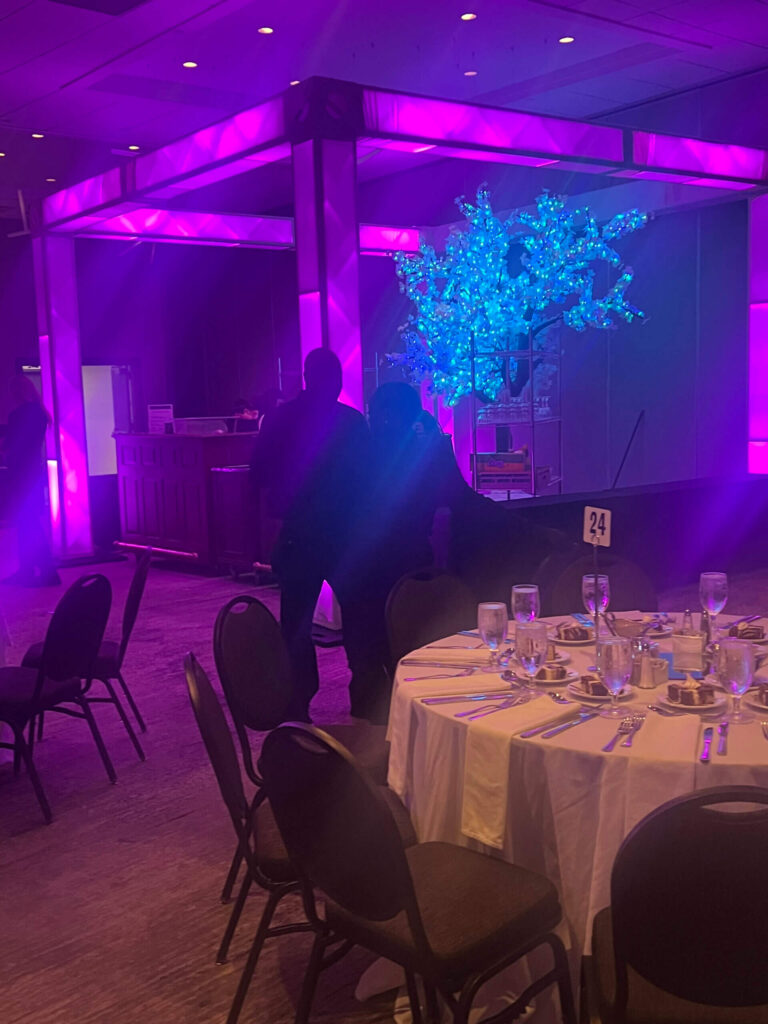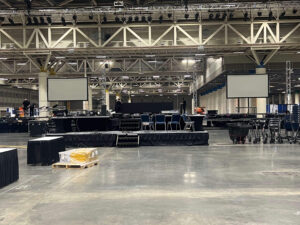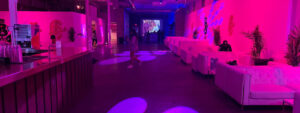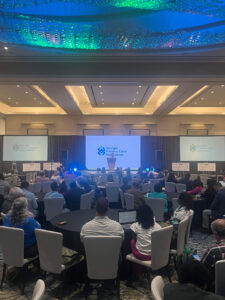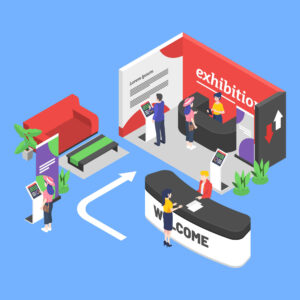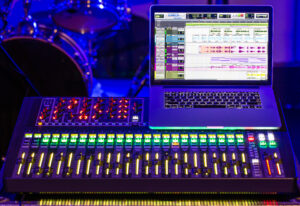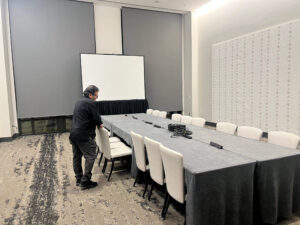Lighting is often the hidden key that turns ordinary spaces into memorable experiences. Whether you’re organizing a wedding, corporate event, concert, or trade show, knowing the most common types of event lighting can help you create the perfect mood.
In this blog, we’ll explore the top 10 types of event lighting we use and explain how each can make your event truly stand out.
1. Uplighting
Uplighting involves placing lights on the floor and directing the beams upward. These lights are usually placed along walls, pillars, or architectural elements. The purpose is to add visual depth and highlight the structure of the space.
Uplights are often LED fixtures, allowing color control to match the event’s theme. You can use a single color for a cohesive look or alternate colors to add variation. For example, weddings might use warm white or pastel tones, while corporate events may opt for brand colors.
The key benefit of uplighting is atmosphere. It makes a room feel intentional and elevated without adding clutter.
2. Gobo Lighting
Gobo lighting projects patterns, logos, or images using a metal or glass stencil placed in front of a light source. It is used to add a custom touch to events, like a couple’s initials at a wedding or a company logo at a product launch. The light shines through the gobo, casting the design onto walls, floors, or ceilings.
You can use static gobos for still images or rotating ones for motion effects. This lighting style creates a strong visual impact without being overly complicated.
3. Pin Spot Lighting
Pin Spot lighting is all about focusing attention. These lights are small and powerful. Spot lighting is like a flashlight that highlights one small thing while everything else stays darker.
The beam from a pin spot is sharp and direct. That’s why it works great for making key elements stand out without lighting up the whole room. The light doesn’t spill over or distract. It’s clean and focused.
Example: At corporate events, they might highlight logos, products, or speakers. In concerts or galas, they can spotlight key performers or awards.
4. Moving Headlights
Moving headlights can move in different directions during an event. They sit on a base that lets them spin, tilt, and turn, so the light beam can go anywhere in the space. You can also change the color, pattern, and speed of the light. These are some of the most flexible and powerful lights used in events.
These lights are often used in concerts, fashion shows, and high-energy events. They can follow a performer on stage, flash in time with music, or create bold patterns on walls and ceilings. You can program them to move smoothly or quickly, depending on the mood you want.
If you’re planning a live concert or high-energy performance, make sure to check out the guide to Concert Lighting Essentials for everything you need to create an unforgettable experience.
5. LED PAR Lights
LED PAR lights are one of the most common types of lights used at events. “PAR” stands for “Parabolic Aluminized Reflector.” They’re bright, flexible lights that are perfect for lighting up large areas, stages, or specific spots.
These lights are shaped like cans and can be placed on the ground, mounted on walls, or hung on trusses. They come in different sizes, but most are compact and easy to move.
When combined with tailored lighting solutions, LED setups can be customized to perfectly match your event’s mood and theme, ensuring every detail shines exactly as you envision.
6. Floodlights
Floodlights are powerful lights that spread bright, wide beams over large areas. They are often used to light up outdoor spaces like concert stages or sports fields during events.
These lights help make sure the whole area is visible and safe. Floodlights are great when you need strong, even lighting without dark spots. They don’t focus on details but cover big spaces.
7. Laser Lights
Laser lights use focused beams of light to create sharp, bright effects. These lights can produce colorful patterns, shapes, or even moving images in the air or on surfaces. They are popular at concerts, clubs, and large events because they grab attention and add excitement.
One big advantage of laser lights is their precision. They can create detailed designs and animations that other lights can’t match. Plus, they use less power compared to traditional lighting while producing very bright effects.
8. String Lights
String lights are one of the simplest and most popular lighting options for events. These are long strands of small light bulbs connected by a wire. You’ve probably seen them at weddings, backyard parties, or outdoor festivals. They’re used to create a soft, warm, and inviting glow.
You can hang string lights across ceilings, wrap them around poles or trees, or drape them along fences. They work well both indoors and outdoors. Because they’re lightweight and flexible, they’re easy to set up and move around as needed.
String lights make any space feel cozy and magical. They don’t shine too bright, but they’re enough to light up an area without being harsh.
String lights, or fairy lights, are easy to use and can be used indoors and outdoors. They create a whimsical and romantic atmosphere in the environment, which is ideal for weddings, garden parties, and holiday events. String lights can be hung over trees, draped over fences, or used to illuminate walkways.
9. Kinetic Lights
Kinetic lights are lights that move. But they don’t just move randomly, they move with purpose, often in sync with music or a planned show. These lights hang from motors that can raise, lower, spin, or shift each light in different directions. Some setups even let each light move on its own, creating amazing patterns in the air.
These lights are usually programmed by software. That means every movement and color change is planned ahead of time.
Kinetic lights grab attention. They turn a basic lighting setup into something exciting and alive. This makes them perfect for high-energy events that need to stand out.
10. Backlighting
Backlighting means placing lights behind a person, object, or surface to make them stand out. Instead of lighting something from the front, you light it from the back. This creates a glow or outline effect that separates the subject from the background.
In events, backlighting is often used on stages, panels, or decor walls. It adds depth and draws attention to a main area, like a performer, speaker, or centerpiece. You’ll also see it behind logos, fabric backdrops, or signs to make them pop without using harsh lighting.
Backlighting doesn’t light up everything. It creates contrast. This is helpful if you want to highlight something without lighting the entire space. For example, putting soft white lights behind a curtain can create a glowing background without distracting the audience.
Many event planners use LED strips or soft panels for backlighting. These can be placed behind drapes, under tables, or inside set pieces. They’re easy to hide and don’t produce much heat, so they’re safe for all types of venues.
11. Architectural Lighting
Architectural lighting highlights the structure and features of a building or venue. It draws attention to walls, columns, windows, entrances, and other design elements. The goal is to make the venue itself part of the event’s visual experience.
This type of lighting is often used to outline the shape of a building, add depth to a stage, or emphasize key structures. It works both indoors and outdoors. For example, at a corporate event, you might light up the venue’s front façade. At a wedding, you might use it to highlight pillars or arches.
Architectural lights are usually placed at the base of the structure and aimed upward. This lighting can match the event’s theme by changing color or brightness. You can go with warm tones for a soft and welcoming look or bold colors for a more dramatic feel.
12. Balloon Lighting
Balloon lighting is a practical and eye-catching way to light large event spaces. It uses large, inflatable balloons with strong internal lights to spread soft, even light across a wide area.
These lights are mounted on stands or rigged overhead. They don’t cast sharp shadows, which makes them perfect for outdoor events, film shoots, festivals, or large indoor venues. They work well in open spaces where typical lighting might not reach.
Balloon lights come in different shapes, like spheres, tubes, or custom designs. Some are plain white to provide clean light. Others can be colored or printed with logos for visual effect or branding. This adds both function and style to your event setup.
These lights are also wind-resistant and safe in different weather conditions, which makes them a strong choice for nighttime outdoor use. They can run on generators or be connected to power outlets, depending on your setup.
How to Choose the Best Event Lighting for Weddings, Corporate Functions & Concerts?
Choosing the right lights for your event depends on a variety of factors, like we check what types of event you are planning to host in what location, mood, and budget. We mention below the useful guide to help you make your decision:
Lighting For Weddings
For weddings, soft and romantic lighting is key. Uplighting, string lights, and pin spot lighting can create an intimate ambiance. Gobo lighting can personalize the space with monograms or patterns.
Lighting For Corporate Functions
Lighting plays a bigger role in corporate functions than most realize. It helps guide attention, sets the right mood for networking, and supports brand visuals during presentations or product launches. If you’re planning a business event, investing in corporate event lighting in Atlanta can make a clear difference in how your guests experience the space and message.
Corporate events often require professional and functional lighting. LED PAR lights and floodlights ensure visibility, while gobo lighting can reinforce branding. Ambient lighting ensures a comfortable environment for attendees.
Lighting For Concerts and Clubs
Dynamic and energetic lighting is essential. Moving headlights, laser lights, and kinetic lighting create an engaging experience. Backlighting can add depth to performances, enhancing the visual impact.
Outdoor Events
Outdoor events benefit from versatile and weather-resistant lighting. Floodlights and balloon lighting provide necessary illumination. String lights add charm, while uplighting can highlight natural features or structures.
Choosing the right lighting depends on the type of event, venue size, and the mood you want to create. Weddings often call for soft, romantic lighting, while corporate functions need clean, professional looks. Concerts need bold, dynamic lighting to match the energy on stage. For a closer look at concert and stage setups, read how to choose the best stage lighting for Your Event to make informed decisions for your next event.
Final Thoughts on Event Lighting Solutions by Huview Production
Huview Productions is an Audio Visual Production Company in Atlanta that stays at the forefront of lighting innovation, helping event planners choose and implement the right lighting solutions that align with their event’s style, scale, and story.
If you’re planning an event and want expert guidance with lighting design and installation, our team of custom lighting designers in Atlanta, GA, is here to help. We’ll work with you every step of the way to ensure your event stands out and leaves a lasting impression.

